

Compact Muon Solenoid
LHC, CERN
| CMS-PAS-TOP-17-015 | ||
| Study of the underlying event in top quark pair production at 13 TeV | ||
| CMS Collaboration | ||
| March 2018 | ||
| Abstract: Normalized differential cross sections as functions of the multiplicity and kinematic variables of charged-particle tracks from the underlying event are measured in top quark and antiquark pair events produced in proton-proton collisions at a center-of-mass energy of 13 TeV. The analysis is based on data collected by the CMS experiment at the LHC in 2016 and corresponding to an integrated luminosity of 35.9 fb$^{-1}$. The selected events contain one electron, one muon, and two jets from the hadronization and fragmentation of b quarks. These measurements characterize, for the first time, the properties of the underlying event at a factorization scale which is typically above twice the top quark mass. The sensitivity of the measured cross sections to different parameters employed in state-of-the-art Monte Carlo simulation programs is demonstrated by comparing the results with different simulations. | ||
|
Links:
CDS record (PDF) ;
CADI line (restricted) ;
These preliminary results are superseded in this paper, EPJC 79 (2019) 123. |
||
| Figures & Tables | Summary | Additional Figures & Tables | References | CMS Publications |
|---|
| Figures | |
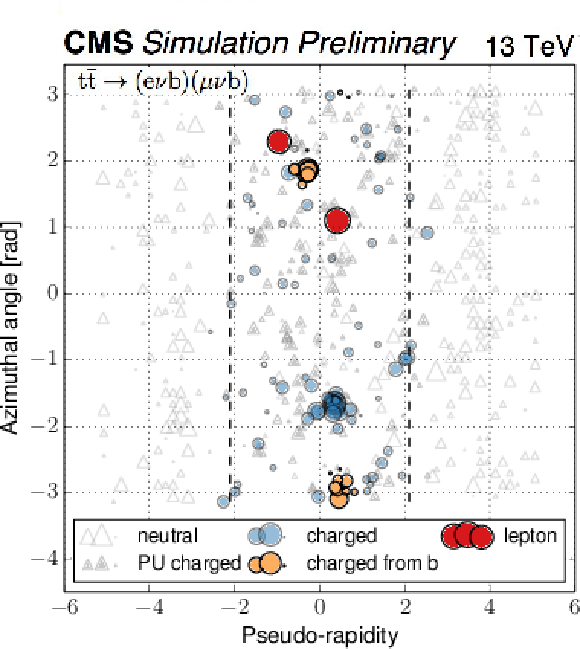
png pdf |
Figure 1:
Distribution of all PF candidates reconstructed in a simulated $ {{\mathrm {t}\overline {\mathrm {t}}}} $ event on the $\eta -\phi $ plane. Only particles with $ {p_{\mathrm {T}}} > $ 900 MeV are shown and the $ {p_{\mathrm {T}}} $ of the particles is proportional to the area of the markers. The fiducial region in $\eta $ is represented by dashed black lines. |
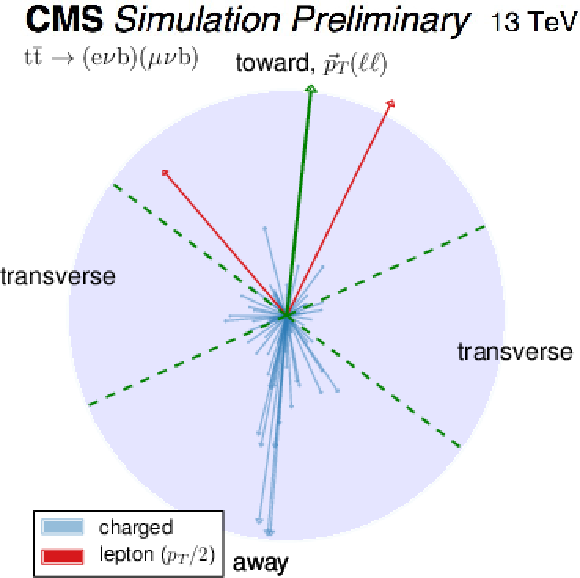
png pdf |
Figure 2:
Display of the momentum of the selected charged particles, the two leptons, and the dilepton pair in the transverse plane corresponding to the same simulated event represented in Fig. 1. The $ {p_{\mathrm {T}}} $ of the particles is proportional to the length of the arrows and the dashed lines represent the regions that are defined relatively to the transverse momentum of the dilepton pair. For clarity, the $ {p_{\mathrm {T}}} $ of the leptons has been rescaled by 0.5. |

png pdf |
Figure 3:
Distributions of the variables used to categorize the study of the UE. Left: multiplicity of additional jets ($ {p_{\mathrm {T}}} > $ 30 GeV). Center: transverse momentum of the dilepton pair. Right: invariant mass of the dilepton pair. The distributions from the data are compared to the sum of the expectations for the signal and backgrounds. |

png pdf |
Figure 3-a:
Distribution of one of the variables used to categorize the study of the UE: multiplicity of additional jets ($ {p_{\mathrm {T}}} > $ 30 GeV). The distribution from the data is compared to the sum of the expectations for the signal and backgrounds. |

png pdf |
Figure 3-b:
Distribution of one of the variables used to categorize the study of the UE: transverse momentum of the dilepton pair. The distribution from the data is compared to the sum of the expectations for the signal and backgrounds. |
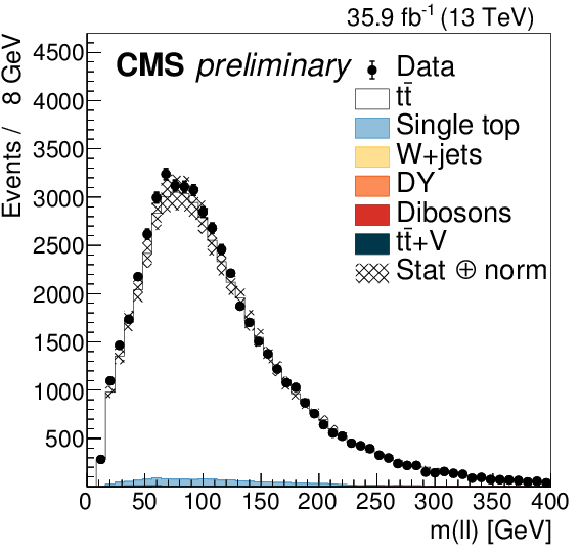
png pdf |
Figure 3-c:
Distribution of one of the variables used to categorize the study of the UE: invariant mass of the dilepton pair. The distribution from the data is compared to the sum of the expectations for the signal and backgrounds. |
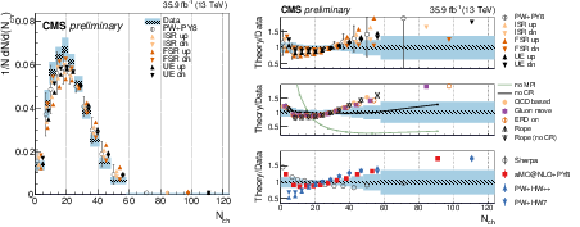
png pdf |
Figure 4:
The normalized differential cross section as function of $N_{\rm ch}$ is shown on the left. The data (colored boxes) are compared to the nominal Pw+Py8 expectations and to the expectations obtained from varied $ {\alpha _S} ^{\rm ISR}$ or $ {\alpha _S} ^{\rm FSR}$ Pw+Py8 setups (markers). Different panels shown on the right display the ratio between each model tested (see text) and the data. In both cases the colored (shaded) band represents the total (statistical) uncertainty of the data, while the error bars represent either the total uncertainty of the Pw+Py8 setup, computed as described in the text, or the statistical uncertainty of the other MC setups. |

png pdf |
Figure 4-a:
The normalized differential cross section as function of $N_{\rm ch}$. The data (colored boxes) are compared to the nominal Pw+Py8 expectations and to the expectations obtained from varied $ {\alpha _S} ^{\rm ISR}$ or $ {\alpha _S} ^{\rm FSR}$ Pw+Py8 setups (markers). |
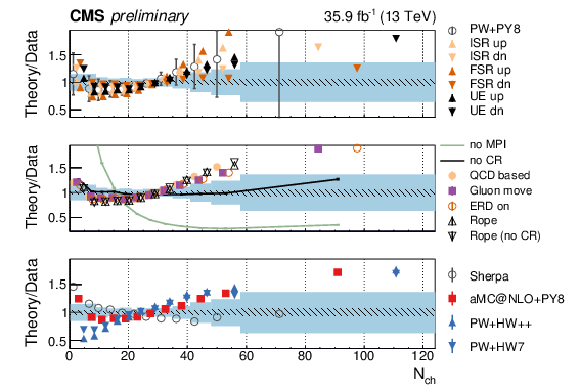
png pdf |
Figure 4-b:
The normalized differential cross section as function of $N_{\rm ch}$. Different panels display the ratio between each model tested (see text) and the data. In both cases the colored (shaded) band represents the total (statistical) uncertainty of the data, while the error bars represent either the total uncertainty of the Pw+Py8 setup, computed as described in the text, or the statistical uncertainty of the other MC setups. |
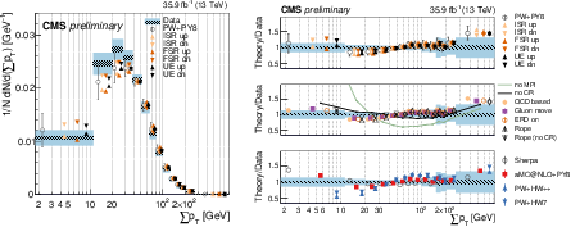
png pdf |
Figure 5:
Normalized differential cross section as function of $ \Sigma p_{\rm T}$, compared to the predictions of different models. The conventions of Fig. 4 are used. |

png pdf |
Figure 5-a:
Normalized differential cross section as function of $ \Sigma p_{\rm T}$, compared to the predictions of different models. The conventions of Fig. 4 are used. |
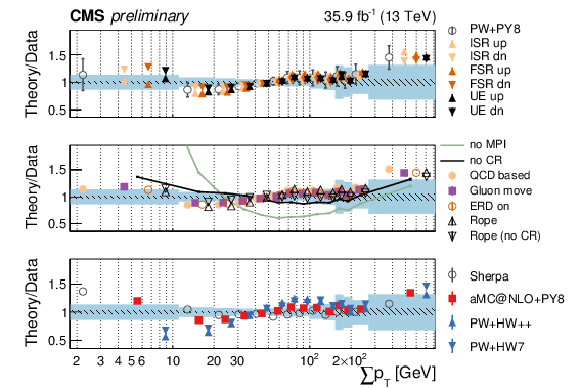
png pdf |
Figure 5-b:
Normalized differential cross section as function of $ \Sigma p_{\rm T}$, compared to the predictions of different models. The conventions of Fig. 4 are used. |
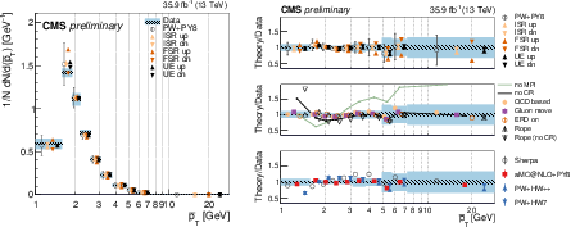
png pdf |
Figure 6:
Normalized differential cross section as function of $\bar{p}_{\rm T}$, compared to the predictions of different models. The conventions of Fig. 4 are used. |

png pdf |
Figure 6-a:
Normalized differential cross section as function of $\bar{p}_{\rm T}$, compared to the predictions of different models. The conventions of Fig. 4 are used. |
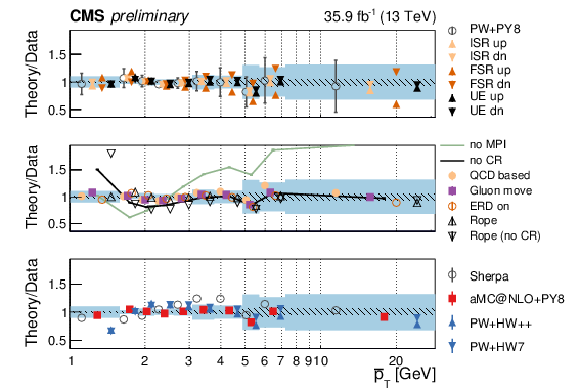
png pdf |
Figure 6-b:
Normalized differential cross section as function of $\bar{p}_{\rm T}$, compared to the predictions of different models. The conventions of Fig. 4 are used. |

png pdf |
Figure 7:
Normalized differential cross section as function of $|\vec{p}_{\rm T}|$, compared to the predictions of different models. The conventions of Fig. 4 are used. |
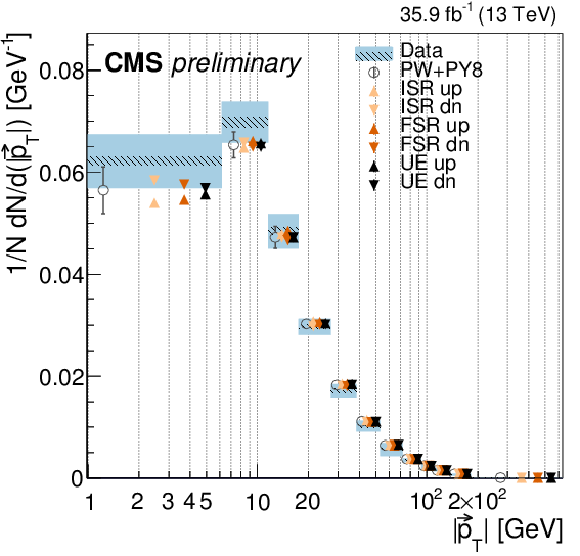
png pdf |
Figure 7-a:
Normalized differential cross section as function of $|\vec{p}_{\rm T}|$, compared to the predictions of different models. The conventions of Fig. 4 are used. |

png pdf |
Figure 7-b:
Normalized differential cross section as function of $|\vec{p}_{\rm T}|$, compared to the predictions of different models. The conventions of Fig. 4 are used. |
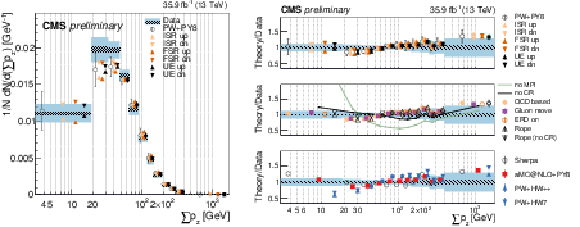
png pdf |
Figure 8:
Normalized differential cross section as function of $\Sigma p_{z}$, compared to the predictions of different models. The conventions of Fig. 4 are used. |
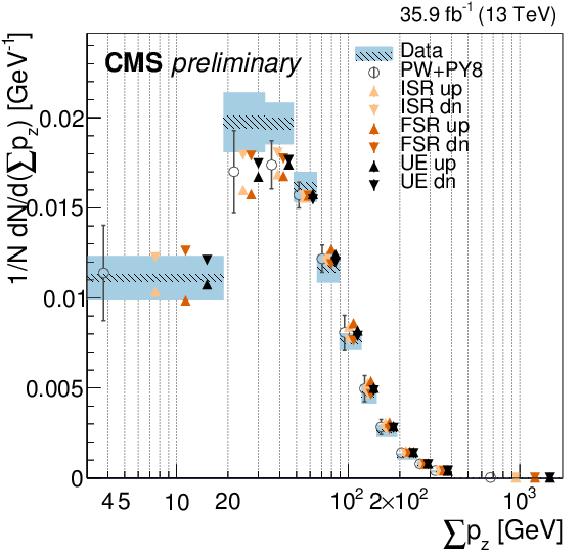
png pdf |
Figure 8-a:
Normalized differential cross section as function of $\Sigma p_{z}$, compared to the predictions of different models. The conventions of Fig. 4 are used. |
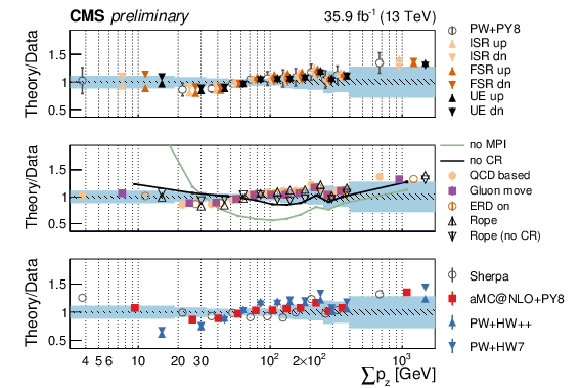
png pdf |
Figure 8-b:
Normalized differential cross section as function of $\Sigma p_{z}$, compared to the predictions of different models. The conventions of Fig. 4 are used. |
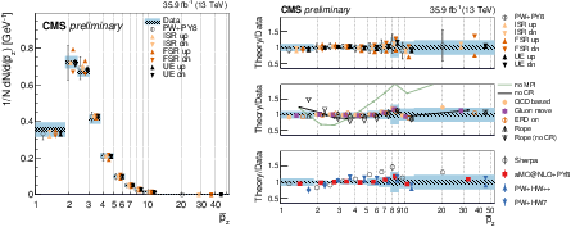
png pdf |
Figure 9:
Normalized differential cross section as function of $\bar{p}_{z}$, compared to the predictions of different models. The conventions of Fig. 4 are used. |

png pdf |
Figure 9-a:
Normalized differential cross section as function of $\bar{p}_{z}$, compared to the predictions of different models. The conventions of Fig. 4 are used. |

png pdf |
Figure 9-b:
Normalized differential cross section as function of $\bar{p}_{z}$, compared to the predictions of different models. The conventions of Fig. 4 are used. |
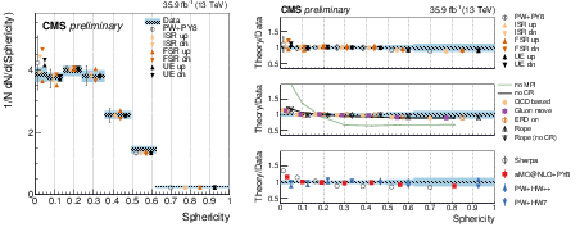
png pdf |
Figure 10:
Normalized differential cross section as function of the sphericity variable, compared to the predictions of different models. The conventions of Fig. 4 are used. |

png pdf |
Figure 10-a:
Normalized differential cross section as function of the sphericity variable, compared to the predictions of different models. The conventions of Fig. 4 are used. |
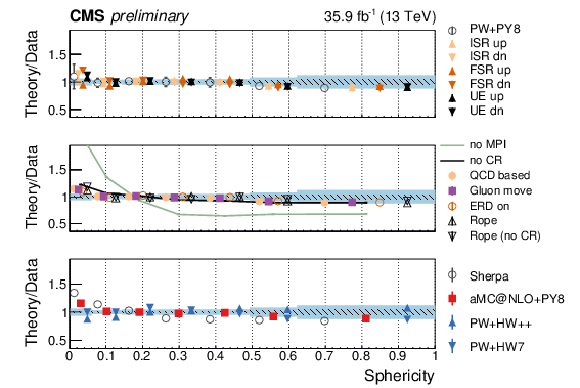
png pdf |
Figure 10-b:
Normalized differential cross section as function of the sphericity variable, compared to the predictions of different models. The conventions of Fig. 4 are used. |

png pdf |
Figure 11:
Normalized differential cross section as function of the aplanarity variable, compared to the predictions of different models. The conventions of Fig. 4 are used. |

png pdf |
Figure 11-a:
Normalized differential cross section as function of the aplanarity variable, compared to the predictions of different models. The conventions of Fig. 4 are used. |

png pdf |
Figure 11-b:
Normalized differential cross section as function of the aplanarity variable, compared to the predictions of different models. The conventions of Fig. 4 are used. |
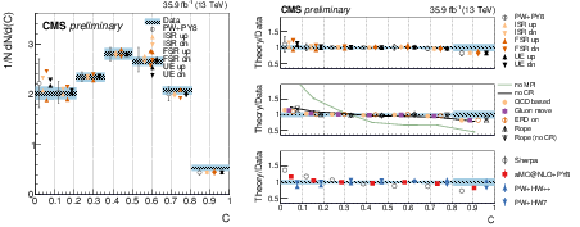
png pdf |
Figure 12:
Normalized differential cross section as function of the $C$ variable, compared to the predictions of different models. The conventions of Fig. 4 are used. |
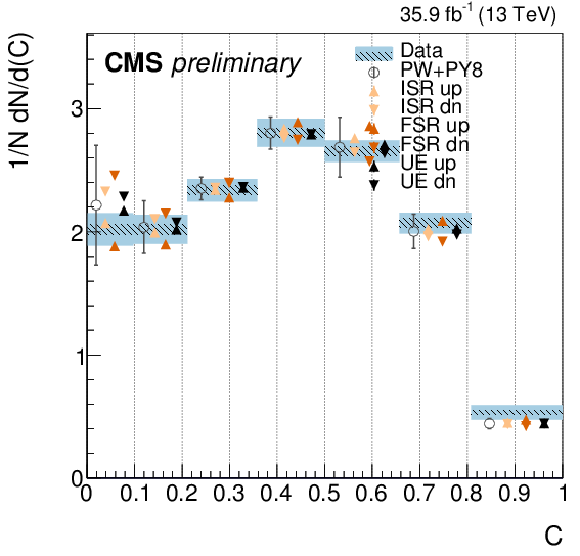
png pdf |
Figure 12-a:
Normalized differential cross section as function of the $C$ variable, compared to the predictions of different models. The conventions of Fig. 4 are used. |

png pdf |
Figure 12-b:
Normalized differential cross section as function of the $C$ variable, compared to the predictions of different models. The conventions of Fig. 4 are used. |

png pdf |
Figure 13:
Normalized differential cross section as function of the $D$ variable, compared to the predictions of different models. The conventions of Fig. 4 are used. |

png pdf |
Figure 13-a:
Normalized differential cross section as function of the $D$ variable, compared to the predictions of different models. The conventions of Fig. 4 are used. |

png pdf |
Figure 13-b:
Normalized differential cross section as function of the $D$ variable, compared to the predictions of different models. The conventions of Fig. 4 are used. |
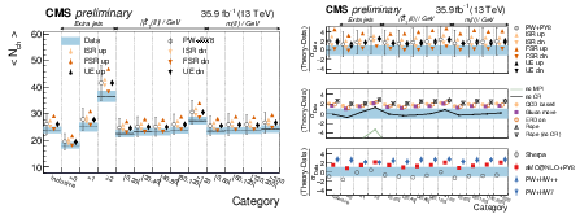
png pdf |
Figure 14:
Average $N_{\rm ch}$ in different event categories. The mean observed in data (boxes) is compared to the predictions from different models (markers), which are superimposed in the left figure. The total (statistical) uncertainty of the data is represented by a filled (dashed) area and the statistical uncertainty of the models is represented with error bars. In the specific case of the Pw+Py8 model the error bars represent the total uncertainty (see text). The right figure displays the pull between the different models and the data, with the different panels corresponding to different sets of models. |

png pdf |
Figure 14-a:
Average $N_{\rm ch}$ in different event categories. The mean observed in data (boxes) is compared to the predictions from different models (markers), which are superimposed in the figure. The total (statistical) uncertainty of the data is represented by a filled (dashed) area and the statistical uncertainty of the models is represented with error bars. In the specific case of the Pw+Py8 model the error bars represent the total uncertainty (see text). |
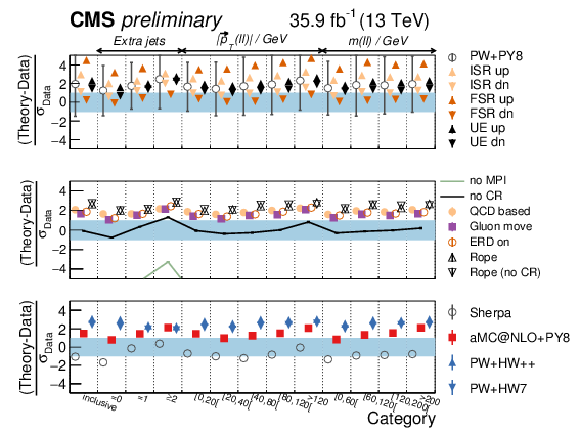
png pdf |
Figure 14-b:
Average $N_{\rm ch}$ in different event categories. The figure displays the pull between the different models and the data, with the different panels corresponding to different sets of models. |
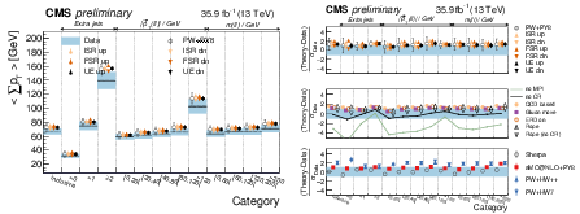
png pdf |
Figure 15:
Average $ \Sigma p_{\rm T}$ in different event categories. The conventions of Fig. 14 are used. |

png pdf |
Figure 15-a:
Average $ \Sigma p_{\rm T}$ in different event categories. The conventions of Fig. 14 are used. |

png pdf |
Figure 15-b:
Average $ \Sigma p_{\rm T}$ in different event categories. The conventions of Fig. 14 are used. |

png pdf |
Figure 16:
Average $\Sigma p_{z}$ in different categories. The conventions of Fig. 14 are used. |
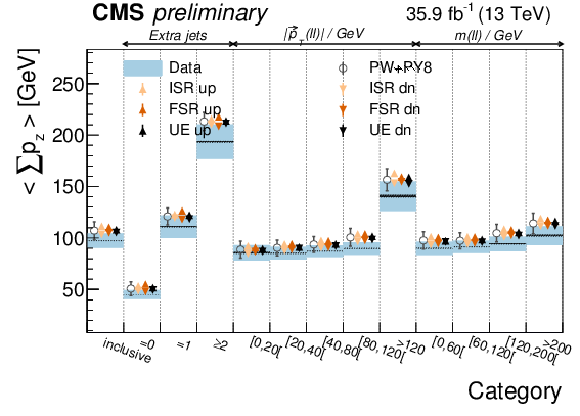
png pdf |
Figure 16-a:
Average $\Sigma p_{z}$ in different categories. The conventions of Fig. 14 are used. |

png pdf |
Figure 16-b:
Average $\Sigma p_{z}$ in different categories. The conventions of Fig. 14 are used. |

png pdf |
Figure 17:
Average $\bar{p}_{\rm T}$ in different categories. The conventions of Fig. 14 are used. |

png pdf |
Figure 17-a:
Average $\bar{p}_{\rm T}$ in different categories. The conventions of Fig. 14 are used. |

png pdf |
Figure 17-b:
Average $\bar{p}_{\rm T}$ in different categories. The conventions of Fig. 14 are used. |
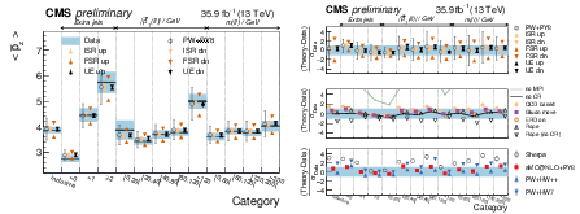
png pdf |
Figure 18:
Average $\bar{p}_{z}$ in different categories. The conventions of Fig. 14 are used. |

png pdf |
Figure 18-a:
Average $\bar{p}_{z}$ in different categories. The conventions of Fig. 14 are used. |

png pdf |
Figure 18-b:
Average $\bar{p}_{z}$ in different categories. The conventions of Fig. 14 are used. |
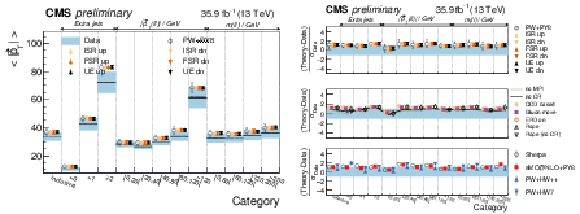
png pdf |
Figure 19:
Average $|\vec{p}_{\rm T}|$ in different categories. The conventions of Fig. 14 are used. |
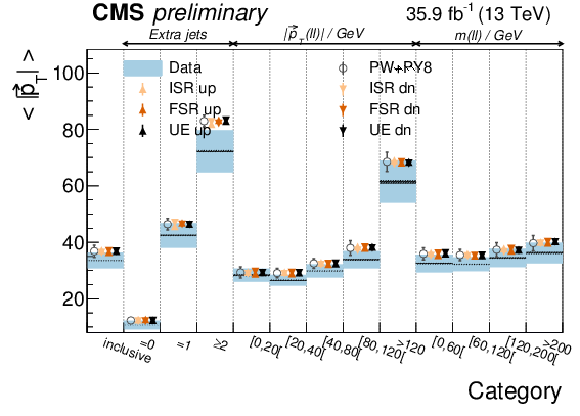
png pdf |
Figure 19-a:
Average $|\vec{p}_{\rm T}|$ in different categories. The conventions of Fig. 14 are used. |

png pdf |
Figure 19-b:
Average $|\vec{p}_{\rm T}|$ in different categories. The conventions of Fig. 14 are used. |

png pdf |
Figure 20:
Average sphericity in different categories. The conventions of Fig. 14 are used. |
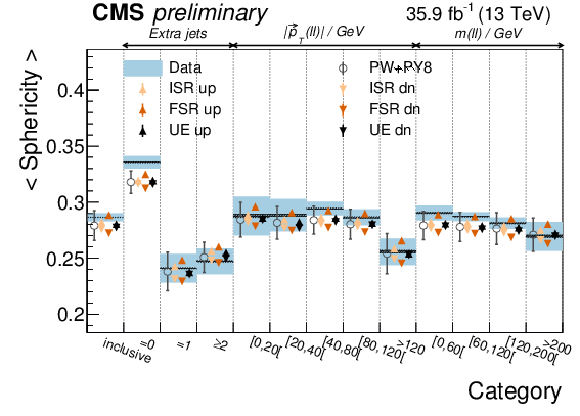
png pdf |
Figure 20-a:
Average sphericity in different categories. The conventions of Fig. 14 are used. |
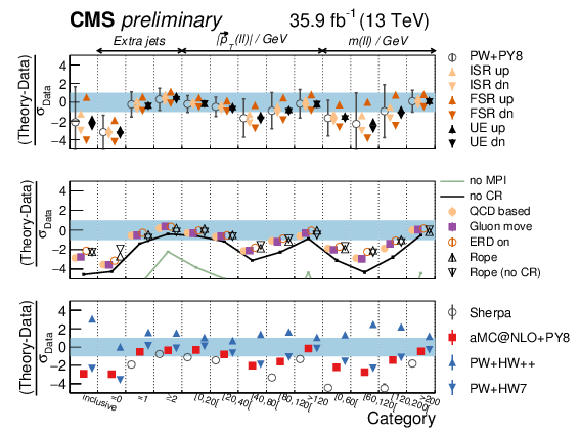
png pdf |
Figure 20-b:
Average sphericity in different categories. The conventions of Fig. 14 are used. |
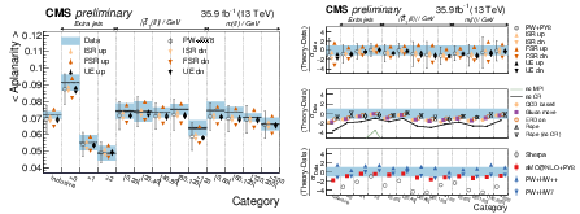
png pdf |
Figure 21:
Average aplanarity in different categories. The conventions of Fig. 14 are used. |

png pdf |
Figure 21-a:
Average aplanarity in different categories. The conventions of Fig. 14 are used. |
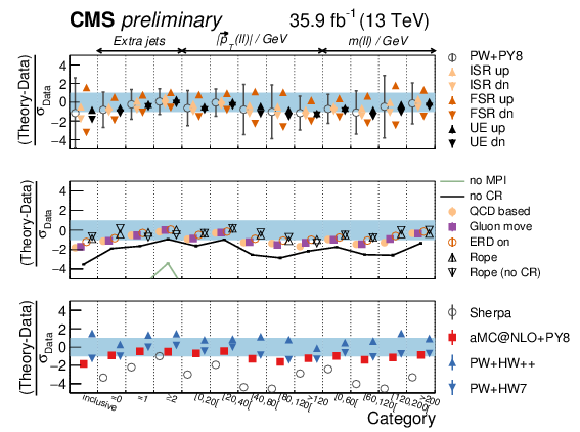
png pdf |
Figure 21-b:
Average aplanarity in different categories. The conventions of Fig. 14 are used. |

png pdf |
Figure 22:
Average C in different categories. The conventions of Fig. 14 are used. |
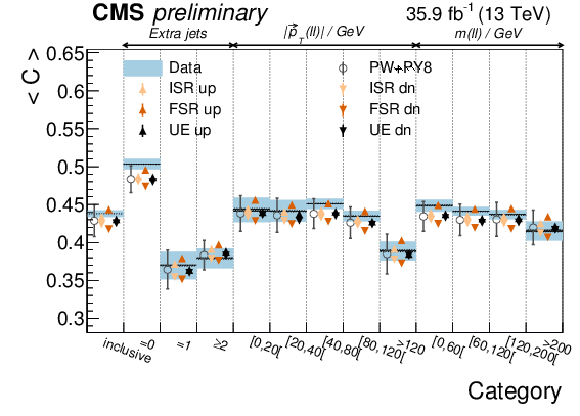
png pdf |
Figure 22-a:
Average C in different categories. The conventions of Fig. 14 are used. |

png pdf |
Figure 22-b:
Average C in different categories. The conventions of Fig. 14 are used. |
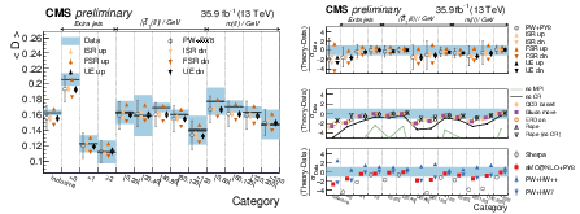
png pdf |
Figure 23:
Average D in different categories. The conventions of Fig. 14 are used. |
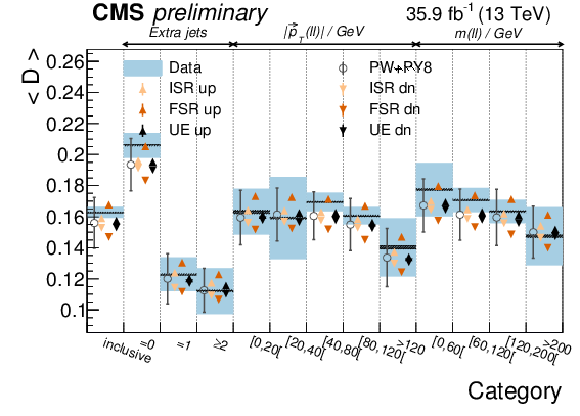
png pdf |
Figure 23-a:
Average D in different categories. The conventions of Fig. 14 are used. |
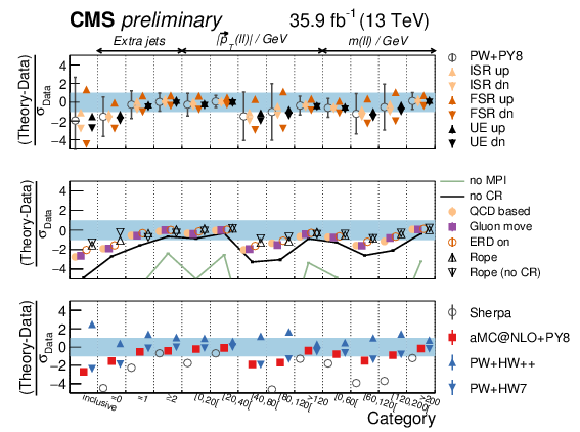
png pdf |
Figure 23-b:
Average D in different categories. The conventions of Fig. 14 are used. |

png pdf |
Figure 24:
Average $\bar{p}_{\rm T}$ in different $|\vec{p}_{\rm T}(\ell \ell)|$ categories. The conventions of Fig. 14 are used. |

png pdf |
Figure 24-a:
Average $\bar{p}_{\rm T}$ in different $|\vec{p}_{\rm T}(\ell \ell)|$ categories. The conventions of Fig. 14 are used. |

png pdf |
Figure 24-b:
Average $\bar{p}_{\rm T}$ in different $|\vec{p}_{\rm T}(\ell \ell)|$ categories. The conventions of Fig. 14 are used. |

png pdf |
Figure 25:
Average $\bar{p}_{\rm T}$ in different $|\vec{p}_{\rm T}(\ell \ell)|$ and jet multiplicity categories. The conventions of Fig. 14 are used. |
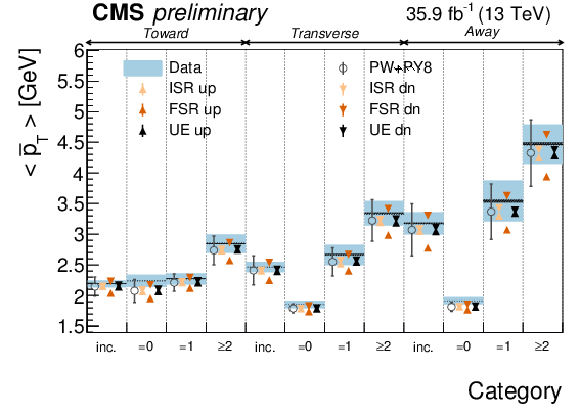
png pdf |
Figure 25-a:
Average $\bar{p}_{\rm T}$ in different $|\vec{p}_{\rm T}(\ell \ell)|$ and jet multiplicity categories. The conventions of Fig. 14 are used. |

png pdf |
Figure 25-b:
Average $\bar{p}_{\rm T}$ in different $|\vec{p}_{\rm T}(\ell \ell)|$ and jet multiplicity categories. The conventions of Fig. 14 are used. |
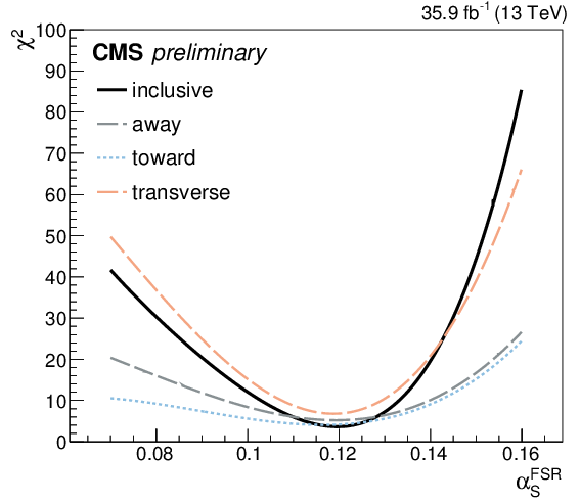
png pdf |
Figure 26:
Scan of the $\chi ^2$ as function of the value of $ {\alpha _S} ^{\rm FSR}$ employed in the Pw+Py8 simulation, when the inclusive $\bar{p}_{\rm T}$ or the $\bar{p}_{\rm T}$ distribution measured in different regions are used. The curves result from a fourth order polynomial interpolation between the simulated $ {\alpha _S} ^{\rm FSR}$ points. For the curve corresponding to the inclusive $\bar{p}_{\rm T}$ distribution, the points mark the simulated $ {\alpha _S} ^{\rm FSR}$ values. |
| Tables | |
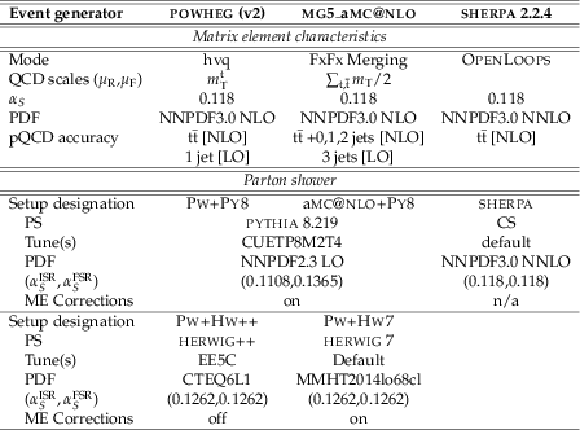
png pdf |
Table 1:
Monte Carlo setups used for the comparisons with the differential cross section measurements of the UE. The table lists the main characteristics and values used for the most relevant parameters of the generators. The row labeled as "Setup designation'' is used to define the abbreviation to be used throughout this paper. |

png pdf |
Table 2:
Uncertainties affecting the measurement of the average of the UE observables. The values are expressed in % and the last row reports the quadratic sum of the individual contributions. |
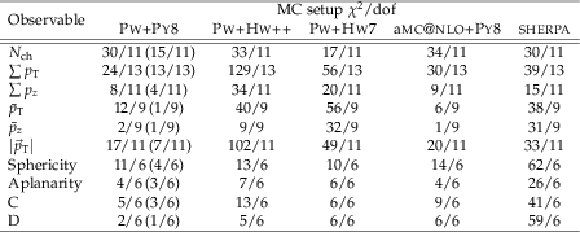
png pdf |
Table 3:
Comparison between the measured distributions at particle level and the predictions of different generator setups. We list the results of the $\chi ^2$ tests together with dof for different MC setups. For the comparison no uncertainties in the predictions are taken into account, except for the Pw+Py8 setup for which the comparison including the theory uncertainties is quoted separately in parenthesis. |

png pdf |
Table 4:
The best fit values for $ {\alpha _S} ^{\rm FSR}$ for the Pw+Py8 setup, obtained from the inclusive distribution of different observables. The 68% and 95.45% confidence intervals are quoted in the last rows. |

png pdf |
Table 5:
Variations of the Pw+Py8 setup used for the comparison with the measurements. The values changed with respect to the CUETP8M2T4 tune are given in the columns corresponding to each model. Further details on parameters or specificities of the models can be looked up in [11,62,3,32,32,4,33,34]. For the rope hadronization model two variations are considered: one with no CR and the other with the default CR model. The settings for the former are denoted in parenthesis in the last column. |
| Summary |
|
The first measurement of the UE activity in $ \mathrm{t\bar{t}} $ dilepton events produced in hadron colliders has been reported, making use of $\sqrt{s} = $ 13 TeV proton-proton collision data acquired by the CMS experiment in 2016. Based on the particle-flow reconstruction [36], the contribution from the underlying event has been isolated by subtracting the charged particles which are associated to the decay products of the $ \mathrm{t\bar{t}} $ event candidates or to pileup events from the set of reconstructed charged particles per event. The chosen observables and categories enhance the sensitivity of the observables to the modeling of multiparton interactions, color reconnection and the choice of ${\alpha_S}^{\rm FSR}$ in the PYTHIA8 parton shower MC. These are among the parameters with largest impact on the modeling of $ \mathrm{t\bar{t}} $ at the LHC. In particular, the compatibility of the data with different choices of the ${\alpha_S}^{FSR}$ parameter in PYTHIA8 has been quantified, resulting in a lower value of ${\alpha_S}^{FSR}$ than Ref. [62]. The majority of the distributions analyzed indicate a fair agreement between the data and the POWHEG+PYTHIA8 setup with the CUETP8M2T4 tune, but disfavor the default settings in HERWIG++, HERWIG7, and SHERPA. It has been furthermore verified that the choice of the NLO matrix-element generator does not impact significantly the expected characteristics of the UE by comparing POWHEG and mg5\_amc@nlo, both interfaced with PYTHIA8. The reported analysis test the universality of the UE hypothesis at higher energy scales than the ones at which the UE models are usually tuned. In addition they can be used to improve the assessment of systematic uncertainties in future top-quark-related analyses. |
| Additional Figures | |
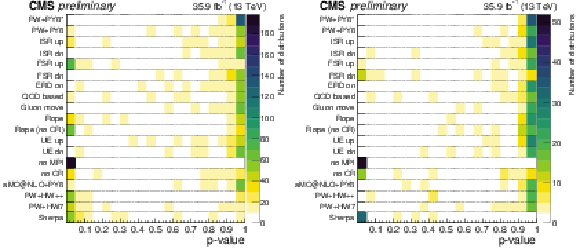
png pdf |
Additional Figure 1:
Distribution of the p-values corresponding to the observed $\chi ^2$ between the different models and distributions analysed. Each row in the figures corresponds to a different model and the color code represents the number of data distributions for which the model has a given p-value. In all cases the $\chi ^2$ includes only the uncertainty associated to the measurements with the exception of the first row, denoted as Pw+Py8$^*$, which includes also the theory uncertainties associated to the model, as described in the text. The left figure includes the analysis of distributions as function of: $N_{\rm ch}$, $\Sigma p_{\rm T}$, $\Sigma p_{z}$, $\bar{p}_{\rm T}$, $\bar{p}_{z}$ and $|\vec{p}_{\rm T}|$. The right figure includes the analysis of event shape distributions: sphericity, aplanarity, C and D. |
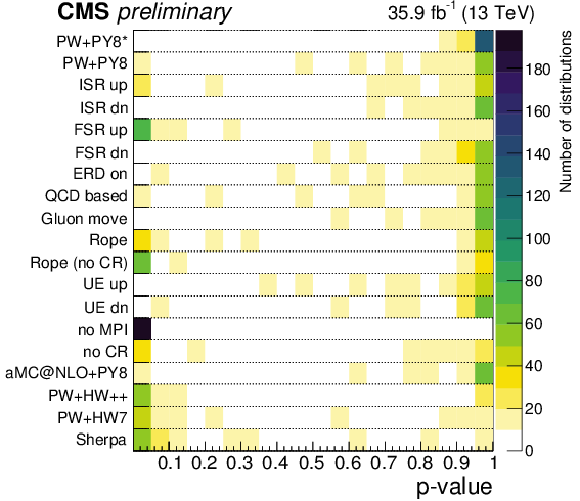
png pdf |
Additional Figure 1-a:
Distribution of the p-values corresponding to the observed $\chi ^2$ between the different models and distributions analysed. Each row in the figure corresponds to a different model and the color code represents the number of data distributions for which the model has a given p-value. In all cases the $\chi ^2$ includes only the uncertainty associated to the measurements with the exception of the first row, denoted as Pw+Py8$^*$, which includes also the theory uncertainties associated to the model, as described in the text. The figure includes the analysis of distributions as function of: $N_{\rm ch}$, $\Sigma p_{\rm T}$, $\Sigma p_{z}$, $\bar{p}_{\rm T}$, $\bar{p}_{z}$ and $|\vec{p}_{\rm T}|$. |
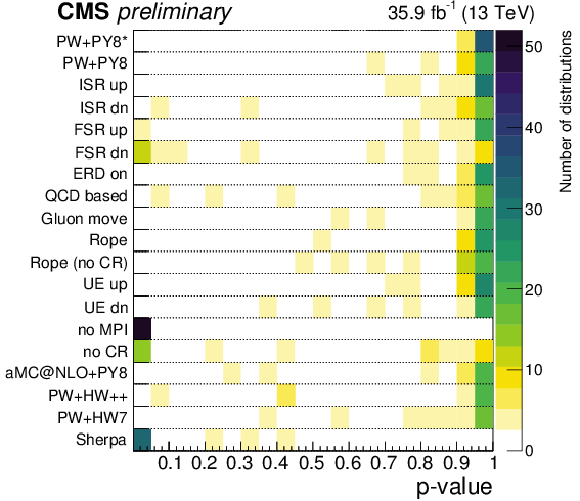
png pdf |
Additional Figure 1-b:
Distribution of the p-values corresponding to the observed $\chi ^2$ between the different models and distributions analysed. Each row in the figure corresponds to a different model and the color code represents the number of data distributions for which the model has a given p-value. In all cases the $\chi ^2$ includes only the uncertainty associated to the measurements with the exception of the first row, denoted as Pw+Py8$^*$, which includes also the theory uncertainties associated to the model, as described in the text. The figure includes the analysis of event shape distributions: sphericity, aplanarity, C and D. |
| Additional Tables | |

png pdf |
Additional Table 1:
The best fit values for $ {\alpha _S} ^{\rm FSR}(m_\mathrm{Z})$ for the Pw+Py8{} setup, obtained from the $\bar{p}_{\rm T}$ distribution in different categories are translated into a preferred value of the renormalization scale ($\mu _{\rm R}$). The $ \pm $1$ \sigma $ interval around a best fit value can be used as an estimate of the variation of the $\mu _{\rm R}$ scale which encompasses the differences between data and the Pw+Py8{} setup. |
| References | ||||
| 1 | Particle Data Group | Review of Particle Physics | CPC 40 (2016) 100001 | |
| 2 | CMS Collaboration | Measurement of the top quark mass using charged particles in pp collisions at $ \sqrt s = $ 8 TeV | PRD 93 (2016) 092006 | CMS-TOP-12-030 1603.06536 |
| 3 | T. Sjostrand | Colour reconnection and its effects on precise measurements at the LHC | 2013 | 1310.8073 |
| 4 | S. Argyropoulos and T. Sjostrand | Effects of color reconnection on $ \rm \mathrm{t\bar{t}} $ final states at the LHC | JHEP 11 (2014) 043 | 1407.6653 |
| 5 | G. Corcella | Interpretation of the top-quark mass measurements: a theory overview | PoS TOP2015 (2016) 037 | 1511.08429 |
| 6 | CMS Collaboration | The CMS experiment at the CERN LHC | JINST 3 (2008) S08004 | CMS-00-001 |
| 7 | P. Nason | A New method for combining NLO QCD with shower Monte Carlo algorithms | JHEP 11 (2004) 040 | 0409146 |
| 8 | S. Frixione, P. Nason, and C. Oleari | Matching NLO QCD computations with Parton Shower simulations: the POWHEG method | JHEP 11 (2007) 070 | 0709.2092 |
| 9 | S. Alioli, P. Nason, C. Oleari, and E. Re | A general framework for implementing NLO calculations in shower Monte Carlo programs: the POWHEG BOX | JHEP 06 (2010) 043 | 1002.2581 |
| 10 | NNPDF Collaboration | Parton distributions for the LHC Run II | JHEP 04 (2015) 040 | 1410.8849 |
| 11 | T. Sjostrand et al. | An Introduction to PYTHIA 8.2 | CPC 191 (2015) 159 | 1410.3012 |
| 12 | CMS Collaboration | Investigations of the impact of the parton shower tuning in $ PYTHIA8 $ in the modelling of $ \mathrm{t\overline{t}} $ at $ \sqrt{s}= $ 8 and 13 TeV | CMS-PAS-TOP-16-021 | CMS-PAS-TOP-16-021 |
| 13 | CMS Collaboration | Event generator tunes obtained from underlying event and multiparton scattering measurements | EPJC 76 (2016) 155 | CMS-GEN-14-001 1512.00815 |
| 14 | CMS Collaboration | Measurement of $ \mathrm {t}\overline{\mathrm {t}} $ production with additional jet activity, including $ \mathrm {b} $ quark jets, in the dilepton decay channel using pp collisions at $ \sqrt{s} = $ 8 TeV | EPJC 76 (2016) 379 | CMS-TOP-12-041 1510.03072 |
| 15 | M. Czakon and A. Mitov | Top++: A program for the calculation of the top-pair cross-section at hadron colliders | CPC 185 (2014) 2930 | |
| 16 | J. Alwall et al. | The automated computation of tree-level and next-to-leading order differential cross sections, and their matching to parton shower simulations | JHEP 07 (2014) 079 | 1405.0301 |
| 17 | R. Frederix and S. Frixione | Merging meets matching in MC@NLO | JHEP 12 (2012) 061 | 1209.6215 |
| 18 | J. Alwall et al. | Comparative study of various algorithms for the merging of parton showers and matrix elements in hadronic collisions | EPJC 53 (2008) 473 | 0706.2569 |
| 19 | T. Melia, P. Nason, R. Rontsch, and G. Zanderighi | $ \mathrm{W}^+ \mathrm{W}^- $, WZ and ZZ production in the POWHEG BOX | JHEP 11 (2011) 078 | 1107.5051 |
| 20 | E. Re | Single-top Wt-channel production matched with parton showers using the POWHEG method | EPJC 71 (2011) 1547 | 1009.2450 |
| 21 | S. Alioli, P. Nason, C. Oleari, and E. Re | NLO single-top production matched with shower in POWHEG: s- and t-channel contributions | JHEP 09 (2009) 111 | 0907.4076 |
| 22 | K. Melnikov and F. Petriello | Electroweak gauge boson production at hadron colliders through $ O(\alpha_s^2) $ | PRD 74 (2006) 114017 | hep-ph/0609070 |
| 23 | N. Kidonakis | Top Quark Production | in Proceedings, Helmholtz International Summer School on Physics of Heavy Quarks and Hadrons (HQ 2013): JINR, Dubna, Russia, July 15-28, 2013, pp. 139--168 2014 | 1311.0283 |
| 24 | J. M. Campbell and R. K. Ellis | MCFM for the Tevatron and the LHC | NPPS 205 (2010) 10 | 1007.3492 |
| 25 | J. M. Campbell, R. K. Ellis, and C. Williams | Vector boson pair production at the LHC | JHEP 07 (2011) 018 | 1105.0020 |
| 26 | T. Gleisberg et al. | Event generation with SHERPA 1.1 | JHEP 02 (2009) 007 | 0811.4622 |
| 27 | F. Cascioli, P. Maierhofer, and S. Pozzorini | Scattering Amplitudes with Open Loops | PRL 108 (2012) 111601 | 1111.5206 |
| 28 | S. Schumann and F. Krauss | A Parton shower algorithm based on Catani-Seymour dipole factorisation | JHEP 03 (2008) 038 | 0709.1027 |
| 29 | M. Bahr et al. | Herwig++ Physics and Manual | EPJC 58 (2008) 639 | 0803.0883 |
| 30 | M. H. Seymour and A. Siodmok | Constraining MPI models using $ \sigma_{eff} $ and recent Tevatron and LHC Underlying Event data | JHEP 10 (2013) 113 | 1307.5015 |
| 31 | J. Bellm et al. | Herwig 7.0/Herwig++ 3.0 release note | EPJC 76 (2016) 196 | 1512.01178 |
| 32 | J. R. Christiansen and P. Z. Skands | String Formation Beyond Leading Colour | JHEP 08 (2015) 003 | 1505.01681 |
| 33 | C. Bierlich, G. Gustafson, L. Lonnblad, and A. Tarasov | Effects of Overlapping Strings in pp Collisions | JHEP 03 (2015) 148 | 1412.6259 |
| 34 | C. Bierlich and J. R. Christiansen | Effects of color reconnection on hadron flavor observables | PRD 92 (2015) 094010 | 1507.02091 |
| 35 | GEANT4 Collaboration | GEANT4: A simulation toolkit | NIMA 506 (2003) 250 | |
| 36 | CMS Collaboration | Particle-flow reconstruction and global event description with the CMS detector | JINST 12 (2017) P10003 | CMS-PRF-14-001 1706.04965 |
| 37 | CMS Collaboration | Measurement of the $ \rm \mathrm{t\bar{t}} $ production cross section using events in the e$ \mu $ final state in pp collisions at $ \sqrt{s} = $ 13 TeV | EPJC 77 (2017) 172 | CMS-TOP-16-005 1611.04040 |
| 38 | CMS Collaboration | Measurements of Inclusive W and Z Cross Sections in pp Collisions at $ \sqrt{s}= $ 7 TeV | JHEP 01 (2011) 080 | CMS-EWK-10-002 1012.2466 |
| 39 | M. Cacciari, G. P. Salam, and G. Soyez | The anti-$ k_t $ jet clustering algorithm | JHEP 04 (2008) 063 | 0802.1189 |
| 40 | M. Cacciari, G. P. Salam, and G. Soyez | FastJet user manual | EPJC 72 (2012) 1896 | 1111.6097 |
| 41 | CMS Collaboration | Identification of heavy-flavour jets with the CMS detector in pp collisions at 13 TeV | Submitted to \it JINST | CMS-BTV-16-002 1712.07158 |
| 42 | CMS Collaboration | Technical proposal for the phase-ii upgrade of the compact muon solenoid | CMS-PAS-TDR-15-002 | CMS-PAS-TDR-15-002 |
| 43 | CMS Collaboration | First Measurement of the Cross Section for Top-Quark Pair Production in Proton-Proton Collisions at $ \sqrt{s}= $ 7 TeV | PLB 695 (2011) 424 | CMS-TOP-10-001 1010.5994 |
| 44 | CMS Collaboration | CMS Luminosity Measurements for the 2016 Data Taking Period | CMS-PAS-LUM-17-001 | CMS-PAS-LUM-17-001 |
| 45 | CMS Collaboration | Object definitions for top quark analyses at the particle level | CDS | |
| 46 | A. Buckley, J. Butterworth, D. Grellscheid et al. | Rivet user manual | CPC 184 (2013) 2803 | 1003.0694 |
| 47 | J. D. Bjorken and S. J. Brodsky | Statistical model for electron-positron annihilation into hadrons | PRD 1 (1970) 1416 | |
| 48 | A. Banfi, G. P. Salam, and G. Zanderighi | Resummed event shapes at hadron - hadron colliders | JHEP 08 (2004) 062 | hep-ph/0407287 |
| 49 | A. Banfi, G. P. Salam, and G. Zanderighi | Phenomenology of event shapes at hadron colliders | JHEP 06 (2010) 038 | 1001.4082 |
| 50 | CMS Collaboration | Description and performance of track and primary-vertex reconstruction with the CMS tracker | JINST 9 (2014) P10009 | CMS-TRK-11-001 1405.6569 |
| 51 | A. Tikhonov | Solution of incorrectly formulated problems and the regularization method | Soviet Math. Dokl. 4 (1963) 1035 | |
| 52 | S. Schmitt | TUnfold: an algorithm for correcting migration effects in high energy physics | JINST 7 (2012) T10003 | 1205.6201 |
| 53 | CMS Collaboration | Performance of Electron Reconstruction and Selection with the CMS Detector in Proton-Proton Collisions at $ \sqrt{s} = $ 8 TeV | JINST 10 (2015) P06005 | CMS-EGM-13-001 1502.02701 |
| 54 | CMS Collaboration | Performance of CMS muon reconstruction in pp collision events at $ \sqrt{s}= $ 7 TeV | JINST 7 (2012) P10002 | CMS-MUO-10-004 1206.4071 |
| 55 | CMS Collaboration | Jet energy scale and resolution in the CMS experiment in pp collisions at 8 TeV | JINST 12 (2017) P02014 | CMS-JME-13-004 1607.03663 |
| 56 | CMS Collaboration | Tracking POG plot results on 2015 data | CMS-DP-2016-012 | |
| 57 | M. Cacciari et al. | The $ \mathrm{t\bar{t}} $ cross-section at 1.8 TeV and 1.96 TeV: A study of the systematics due to parton densities and scale dependence | JHEP 04 (2004) 068 | hep-ph/0303085 |
| 58 | S. Catani, D. de Florian, M. Grazzini, and P. Nason | Soft gluon resummation for Higgs boson production at hadron colliders | JHEP 07 (2003) 028 | hep-ph/0306211 |
| 59 | CMS Collaboration | Measurement of differential cross sections for top quark pair production using the lepton+jets final state in proton-proton collisions at 13 TeV | PRD 95 (2017) 092001 | CMS-TOP-16-008 1610.04191 |
| 60 | CMS Collaboration | Measurement of normalized differential $ \mathrm{t\bar{t}} $ cross sections in the dilepton channel from pp collisions at $ \sqrt{s} = $ 13 TeV | Submitted to PRLett | CMS-TOP-16-007 1708.07638 |
| 61 | CMS Collaboration | Measurement of the top quark mass using proton-proton data at $ {\sqrt{s}} = $ 7 and 8 TeV | PRD 93 (2016) 072004 | CMS-TOP-14-022 1509.04044 |
| 62 | P. Skands, S. Carrazza, and J. Rojo | Tuning PYTHIA 8.1: the Monash 2013 Tune | EPJC 74 (2014) 3024 | 1404.5630 |

|
Compact Muon Solenoid LHC, CERN |

|

|

|

|

|

|